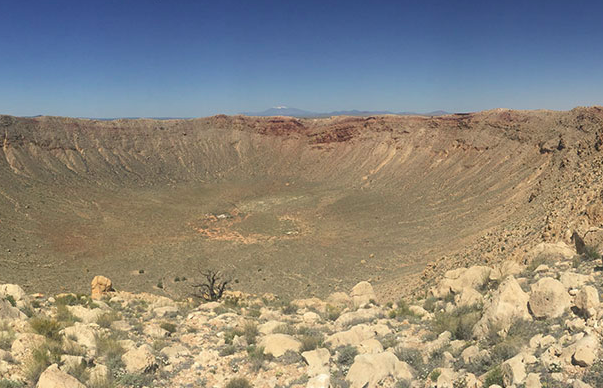Here, Dr G. R. Osinski, Professor at Western University, explores the positive and negative impacts meteorites have on Earth
Impact Earth
One of the most magical moments on a clear, dark night, is to witness a shooting star. Technically known as meteors, shooting stars are bright streaks across the night sky formed when pieces of dust and small millimetre to centimetre-size particles from space burn up harmlessly in Earth’s atmosphere. As the size of a particle increases – up to 10s of centimetres to perhaps a metre or two – there is a high likelihood that all or part of it will remain more-or-less intact and survive passage through the atmosphere, being slowed down and landing on the Earth’s surface at low velocity. For anybody lucky enough to find these space rocks, we refer to them as meteorites.
Most meteorites cause very little damage, with only the occasional broken window or roof typically being reported. This is not the case for objects greater than a few 10s of metres in diameter! There are literally thousands of asteroids and comets larger than 50 m and up to 100s of kilometres in size scattered throughout our Solar System. When one of these objects approaches the Earth, they do so at staggering velocities: with averages of 15 – 20 km/sec for an asteroid and over 70 km/sec for comets. These objects are not slowed down by the Earth’s atmosphere and instead deposit a huge amount of energy at a single point in the Earth’s crust to form hypervelocity impact craters.
Meteorite impacts as a planetary process
During the latter part of the 20th century, the realisation that asteroids and comets have struck, and continue to strike, the Earth throughout time has revolutionised our understanding of how the Earth and other solar system objects formed and evolved over the past 4.5 billion years. The pioneering 18th-century concept of uniformitarianism as a central tenet of geology, in which change occurs gradually, has given way to the idea that periodic cataclysmic impact events have greatly affected the origin and geological evolution of Earth, its climate, and the habitability of our planet. The Earth’s impact crater record, which represents a tiny fraction of the number of craters that have formed over the past 4.5 billion years, now stands at 200 and has been instrumental in developing our growing understanding of the importance of meteorite impacts as a planetary process.
Meteorite impacts: The bad news
The destructive effects of meteorite impacts are now well established. This is due in a large part to the proposal in 1980 by Luis and Walter Alvarez for an extraterrestrial origin for the most recent of the “big five” mass extinctions: the Cretaceous-Tertiary (now the Cretaceous–Paleogene) event that occurred ~66 million years ago during which two-thirds of species on Earth went extinct. In the early 1990s, the source crater – the 200 km diameter Chicxulub impact structure – was found buried beneath ~1 km of sediment below and offshore the present-day Yucatan Peninsula, Mexico. Research throughout the ensuing decades has demonstrated that the Chicxulub impact created gigantic tsunamis and earthquakes, ejected huge amounts of dust and debris, ignited wildfires around the world, and released vast quantities of sulfur aerosols into the atmosphere. The combined result was an environment akin to that envisaged in a nuclear winter with a 15 ºC decrease in the average global temperatures. In short, large meteorite impacts the scale of Chicxulub cause global destructive effects and would result in the end of civilisation as we know it should one occur again in the future – thankfully, the odds of this are extremely low!
Meteorite impacts: The good news
It is hard then to imagine that meteorite impact events can be anything other than cataclysmic destructive events. However, in recent years, research conducted on terrestrial impact craters, as well as experimental and numerical modelling studies, have shown that impact events also have beneficial effects for microbial life and may have played an important, and perhaps central role, in creating the conditions suitable for life to emerge on Earth around 4 billion years ago. These beneficial effects range from generating conditions conducive for the origin of life, such as hot spring environments and clays, which form catalysts for organic reactions, to varied habitats for life that persist long after an impact event. These habitats include impact-generated hydrothermal systems, impact crater lakes, and porous shocked rocks that resemble volcanic pumice and impact glasses that provide habitats for endolithic organisms, i.e., microbes that live within, rather than on the surface, of rocks.
The beneficial effects of meteorite impacts also extend to the present-day economy. It has been estimated that about one-quarter of all impacts on Earth have resulted in economic benefits, from building materials and hydroelectric reservoirs to economic ore and hydrocarbon deposits. The ~250 km diameter Sudbury impact structure in Ontario, is the most exceptional example. Mined for over a century, Sudbury accounts for close to half the mining activity in Ontario, the value of which is ~$10 billion annually. From a historical focus on Nickel and Copper – of which about 20,000 tons each of which have been extracted – mining and exploration at the present day is increasingly focused on platinum group elements needed for the green economy.
To conclude, our understanding of meteorite impact events and their effects is continually evolving, but what is clear is that, depending on your viewpoint, they have resulted in both good and bad outcomes for our planet and for life as we know it.
Please note: This is a commercial profile











